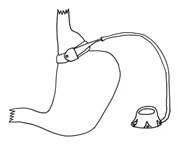
 The digestive system allows the body to take food and utilize it for
nurishment for the body. Normally, this meets the body's
immediate energy (caloric) requirements and allows for energy storage
in the form of fat for times when food is not available. When humans
evolved food was not easy to obtain so the body needed to adapt so it
could store energy during times of fasting. The process starts
in the mouth where salivary amylase breaks down foodstuffs. The
process continues with the
stomach, which in itself acts as a storage depot. The
stomach's acids continue to break down chewed food
materials. The food is released in small quantities into the
duodenum where enzymes break down the material into substances that are
easily absorbed throughout the twenty foot length of the small
intestines. This includes proteins, carbohydrates, fats, fiber,
vitamins and minerals. Towards the end of the intestinal tract in the
large intestines, water is absorbed and waste material is concentrated
for expulsion.
The digestive system allows the body to take food and utilize it for
nurishment for the body. Normally, this meets the body's
immediate energy (caloric) requirements and allows for energy storage
in the form of fat for times when food is not available. When humans
evolved food was not easy to obtain so the body needed to adapt so it
could store energy during times of fasting. The process starts
in the mouth where salivary amylase breaks down foodstuffs. The
process continues with the
stomach, which in itself acts as a storage depot. The
stomach's acids continue to break down chewed food
materials. The food is released in small quantities into the
duodenum where enzymes break down the material into substances that are
easily absorbed throughout the twenty foot length of the small
intestines. This includes proteins, carbohydrates, fats, fiber,
vitamins and minerals. Towards the end of the intestinal tract in the
large intestines, water is absorbed and waste material is concentrated
for expulsion. Restrictive operations for obesity include laproscopic gastric banding
of the stomach. A hollow tube or band of an inert material is
placed
around the stomach. A small port is placed under the skin that
allows the physician to fill the tube with salt water. When the
tube fills it tightens around the stomach creating a smaller depot for
food (see figure below). This is one of the easiest procedures to
perform and is
safer than a malabsorptive procedure. The surgery and hospital
stay is shorter and there are fewer nutritional deficiencies.
However, weight loss is less. Although patients lose about 50% of
their weight during the first year, less than 20% keep it off after 10
years. The problem resides in the fact that unless one modifies
their eating habits they are able to work around the surgical solution
by eating softer foods or just continue to eat in excess despite
feeling full. Ultimately, success depends on diet modification
and exercize and not the gastric bypass procedure alone. For more
information on gastric banding click here.
Restrictive operations for obesity include laproscopic gastric banding
of the stomach. A hollow tube or band of an inert material is
placed
around the stomach. A small port is placed under the skin that
allows the physician to fill the tube with salt water. When the
tube fills it tightens around the stomach creating a smaller depot for
food (see figure below). This is one of the easiest procedures to
perform and is
safer than a malabsorptive procedure. The surgery and hospital
stay is shorter and there are fewer nutritional deficiencies.
However, weight loss is less. Although patients lose about 50% of
their weight during the first year, less than 20% keep it off after 10
years. The problem resides in the fact that unless one modifies
their eating habits they are able to work around the surgical solution
by eating softer foods or just continue to eat in excess despite
feeling full. Ultimately, success depends on diet modification
and exercize and not the gastric bypass procedure alone. For more
information on gastric banding click here.| Additional Resource |
American Society for Bariatric and Gastric Bypass Surgery |